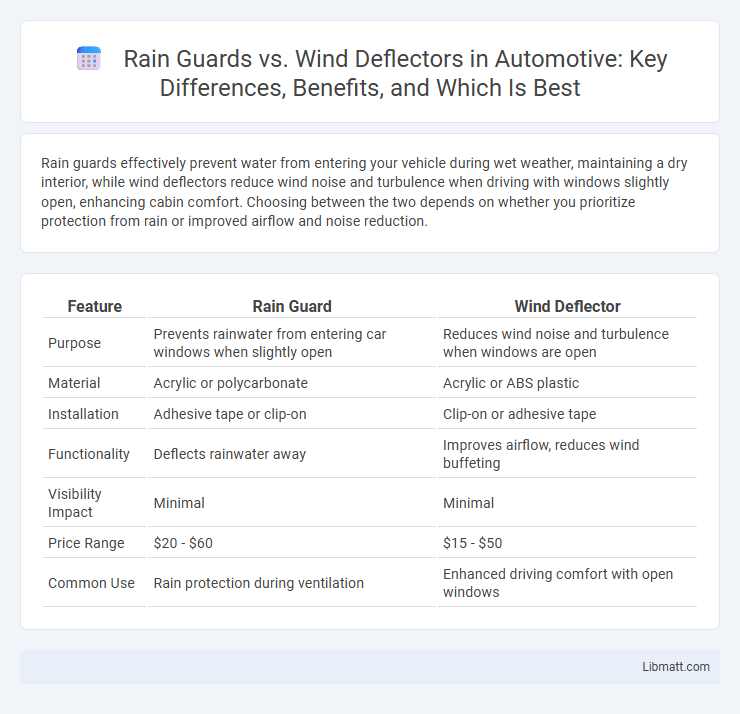Rain guards effectively prevent water from entering your vehicle during wet weather, maintaining a dry interior, while wind deflectors reduce wind noise and turbulence when driving with windows slightly open, enhancing cabin comfort. Choosing between the two depends on whether you prioritize protection from rain or improved airflow and noise reduction.
Table of Comparison
| Feature | Rain Guard | Wind Deflector |
|---|---|---|
| Purpose | Prevents rainwater from entering car windows when slightly open | Reduces wind noise and turbulence when windows are open |
| Material | Acrylic or polycarbonate | Acrylic or ABS plastic |
| Installation | Adhesive tape or clip-on | Clip-on or adhesive tape |
| Functionality | Deflects rainwater away | Improves airflow, reduces wind buffeting |
| Visibility Impact | Minimal | Minimal |
| Price Range | $20 - $60 | $15 - $50 |
| Common Use | Rain protection during ventilation | Enhanced driving comfort with open windows |
Introduction to Rain Guards and Wind Deflectors
Rain guards and wind deflectors enhance vehicle comfort by managing airflow and weather protection. Rain guards allow you to keep windows slightly open during rain, reducing interior moisture without letting water in. Wind deflectors minimize wind noise and turbulence, improving your driving experience at higher speeds.
What Are Rain Guards?
Rain guards are aerodynamic window accessories designed to shield vehicle occupants from rain while allowing fresh air circulation when windows are slightly open. Made from durable acrylic or polycarbonate, rain guards prevent water from entering the cabin during inclement weather, enhancing comfort without compromising visibility. They also help reduce wind noise and sun glare, contributing to a safer and more pleasant driving experience.
What Are Wind Deflectors?
Wind deflectors are aerodynamic accessories installed on car windows to reduce wind noise and turbulence while driving with windows slightly open. These devices improve airflow around the vehicle, enhancing comfort by minimizing wind buffeting and allowing you to enjoy fresh air without the disruption of strong drafts. Unlike rain guards that primarily protect against water, wind deflectors are optimized for aerodynamic performance and noise reduction.
Key Differences Between Rain Guards and Wind Deflectors
Rain guards primarily prevent rainwater from entering a vehicle while windows are slightly open, enhancing weather protection and ventilation. Wind deflectors reduce wind noise and turbulence by altering airflow around open windows, improving driving comfort at higher speeds. Both accessories contribute to improved cabin environment but serve distinct functions: rain guards focus on water protection, while wind deflectors emphasize aerodynamic efficiency and noise reduction.
Benefits of Rain Guards
Rain guards provide enhanced protection against rain, preventing water from entering the vehicle when windows are slightly open, which improves ventilation without compromising comfort. Their aerodynamic design reduces wind noise and minimizes wind buffeting, contributing to a quieter and more enjoyable driving experience. Additionally, rain guards help maintain a cooler interior by allowing fresh air circulation while keeping rain out, reducing the need for air conditioning and enhancing fuel efficiency.
Advantages of Wind Deflectors
Wind deflectors significantly improve cabin ventilation by allowing fresh air circulation while minimizing wind noise and turbulence. They enhance driving comfort by reducing wind buffeting and preventing rainwater from entering the vehicle when windows are slightly open. This feature also helps maintain interior air quality and temperature control without the need for air conditioning.
Installation Process: Rain Guards vs Wind Deflectors
Rain guards typically require clipping or adhesive application along the top edge of vehicle windows, making the installation straightforward and often do not need professional help. Wind deflectors may have similar mounting methods but sometimes involve more precise alignment to ensure optimal airflow and noise reduction, occasionally requiring tools for a more secure fit. Choosing the right option depends on your comfort with installation and whether you prefer a quick setup or a more tailored fit for your vehicle.
Factors to Consider When Choosing
When choosing between a rain guard and a wind deflector, consider your primary driving conditions and climate; rain guards are designed to keep rain out while allowing fresh air circulation, ideal for wet weather. Wind deflectors reduce wind noise and turbulence when windows are slightly open, enhancing comfort during breezy or dry conditions. Evaluate your vehicle type, window size, and whether you prioritize weather protection or noise reduction to select the best option for your needs.
Cost Comparison: Rain Guards vs Wind Deflectors
Rain guards typically cost between $30 and $70 per set, offering a budget-friendly option for protecting your vehicle's windows from rain while slightly reducing wind noise. Wind deflectors, often priced higher at around $50 to $100, provide enhanced aerodynamic benefits by redirecting airflow to reduce wind turbulence and increase cabin ventilation. Your choice between rain guards and wind deflectors should consider both the upfront expense and the specific performance advantages you seek for interior comfort and weather protection.
Which Is Best for Your Vehicle?
Rain guards are designed to prevent rain from entering your vehicle when windows are slightly open, enhancing ventilation without water intrusion, while wind deflectors minimize wind noise and turbulence at higher speeds, improving driving comfort. Choosing between the two depends on your priority: opt for rain guards if you frequently drive in wet weather and want to keep your cabin dry, or select wind deflectors if wind noise reduction and aerodynamic performance are your main concerns. Both accessories are typically vehicle-specific and easy to install, making them practical upgrades for enhancing driving experience.
Rain guard vs Wind deflector Infographic

 libmatt.com
libmatt.com